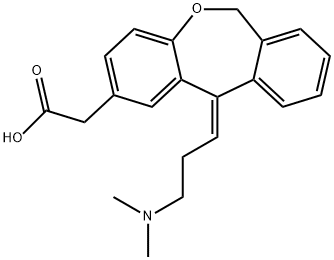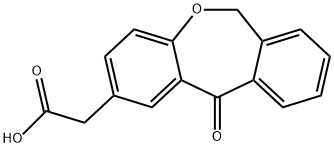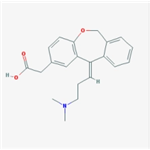Description
Olopatadine belongs to a kind of antihistamine reagent. It is a relatively selective H1-receptor antagonist and can inhibit the histamine release process from the mast cell, subsequently leading to temporary relief on the negative symptoms associated with histamine. It is devoid of effects on alpha-adrenergic, dopamine and muscarinic type I and II receptors. Its 0.1% solution can be used for topical administration to the eyes. It is indicated for the treatment of itching associated with allergic conjunctivitis.
Manufacturing Process
402.4 g of phthalide and 200 g of sodium chloride and equal molecular
quantity of p-hydroxyphenyl acetic acid are mixed with one another and
stirred at 150°C for 6 hours. After completion of the reaction, the mixture is
cooled until the temperature is brought back to room temperature, 4 L of
aqueous 10% acetic acid solution is added thereto and the mixture is allowed
to stand at room temperature overnight. After stirring the mixture at room
temperature for 3 hours, deposited crystals are separated by filtration, and 6
L of water is added thereto. After stirring the mixture at room temperature for
30 minutes, the deposited crystals are separated by filtration. After the
addition of 3 L of toluene to the crystals, the mixture is stirred at room
temperature for one hour. The crystals are separated by filtration and dried
over heating under reduced pressure to yield of 2-(4-acetoxyphenoxy)benzoic
acid.
266.0 g of trifluoroacetic anhydride is added to the equal molecular quantity
of 2-(4-acetoxyphenoxy)benzoic acid suspended in 5.0 L of methylene chloride
and thereto. After stirring the mixture at room temperature for one hour, 19.4
g of boron trifluoride-ethylether complex is added thereto and the mixture is
stirred at room temperature for two hours. The reaction solution is poured
into ice water. After an organic solvent layer is separated from the mixture,
the organic layer is washed with diluted aqueous sodium hydroxide solution
and water, dried over anhydrous magnesium sulfate and concentrated under
reduced pressure to obtain 335.3 g of methyl 11-oxodibenz[b,e]oxepin-2-
carboxylate as a white crystal melting point 130°-132°C
Methyl 11-methylene-6,11-dihydrodibenz-[b,e]oxepin-2-acetate.
In 100 ml of tetrahydrofuran is suspended 25 g of
methyltriphenylphosphonium bromide and 40 ml of 1.6 N n-butyl lithium
hexane solution is dropwise added thereto under a nitrogen atmosphere and
ice-cooling. After stirring the mixture under ice-cooling for 30 minutes, a
solution obtained by dissolving equal molar quantity of 11-oxo-6,11-
dihydrodibenz[b,e]oxepin-2-acetic acid in 250 ml of tetrahydrofuran is
dropwise added thereto and the mixture is stirred at room temperature for
two hours. The solvent is distilled away under reduced pressure and the
residue is purified by column chromatography on silica gel (eluent:
hexane:ethyl acetate = 3:1) to obtain the desired product as a colorless oily matter.
References
https://www.drugbank.ca/drugs/DB00768
http://www.rxlist.com/patanol-drug/clinical-pharmacology.htm
https://en.wikipedia.org/wiki/Olopatadine




